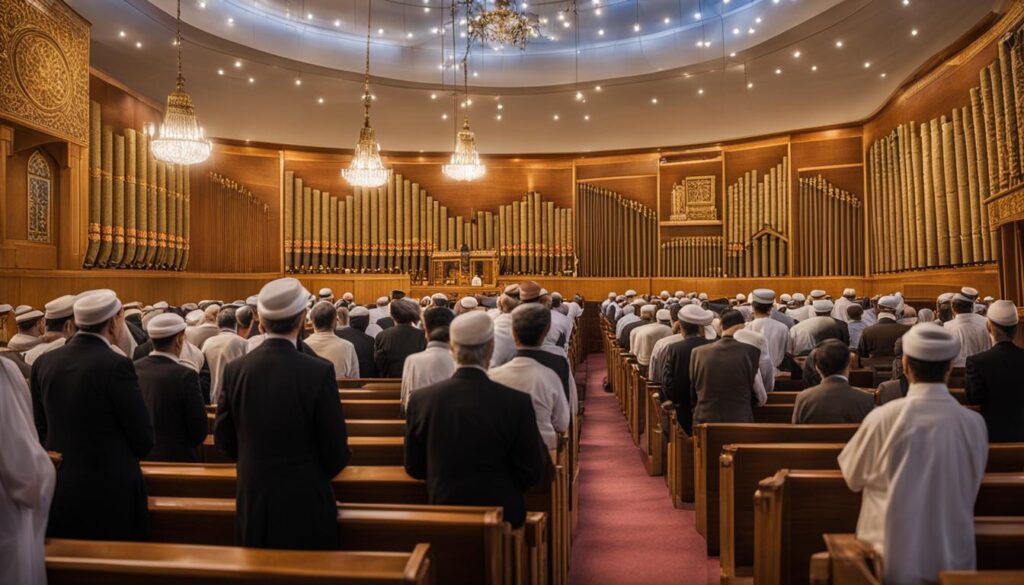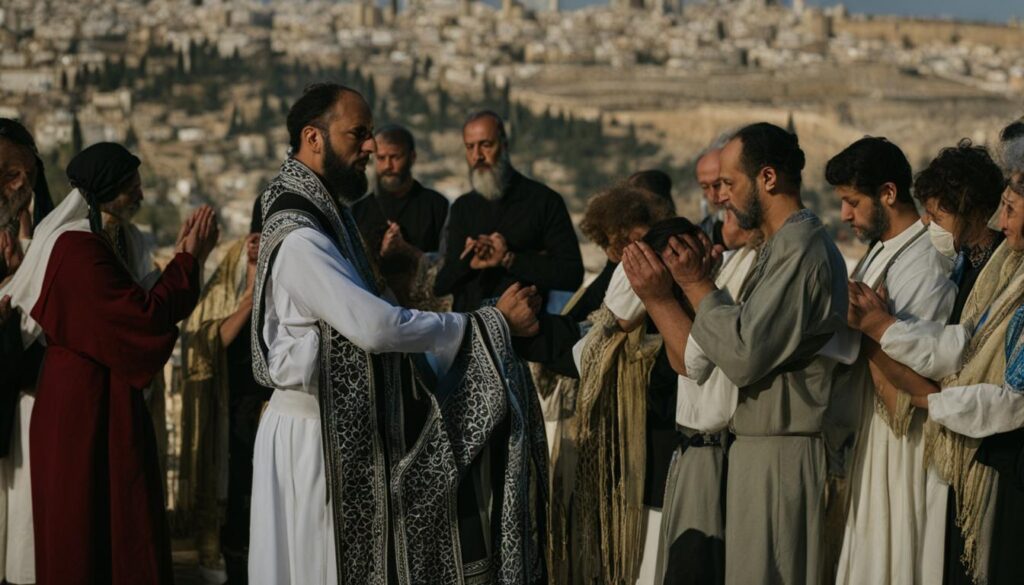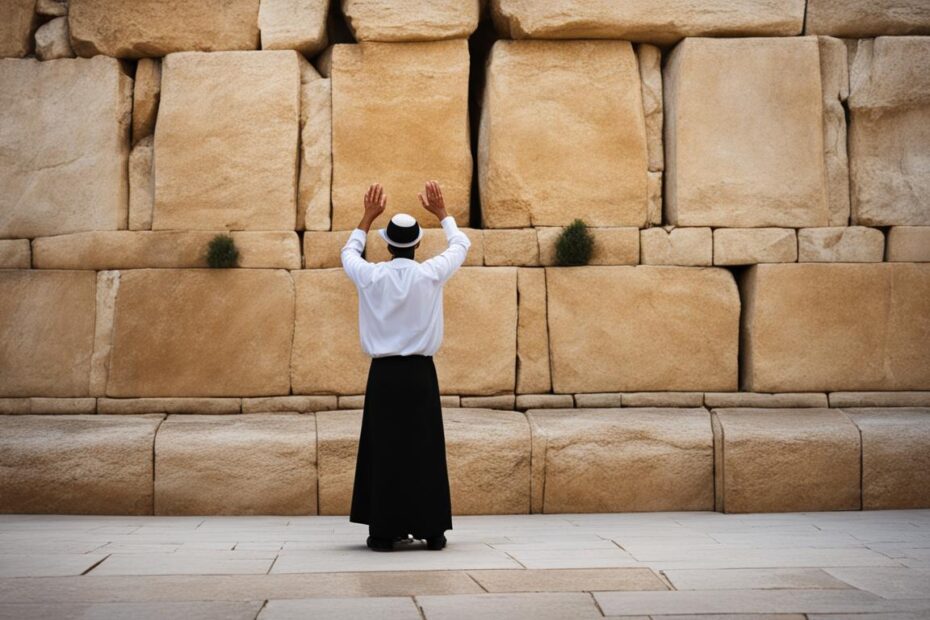Judaism places a profound significance on prayer, which serves as a vital link between individuals and God. It holds a central role in Jewish worship practices and is deeply rooted in Jewish heritage. Prayer in Judaism is guided by the Siddur, a prayer book that contains a collection of prayers and blessings for various occasions and times of the day.
Key Takeaways:
- Prayer in Judaism serves as a means of connecting with God and expressing gratitude.
- The Siddur, a Jewish prayer book, provides a structured framework for prayer.
- Prayer is integrated into various Jewish rituals, traditions, and lifecycle events.
- Jewish prayer services follow a structured format and are held in synagogues.
- Prayer in Judaism fosters a sense of community and unity.
The Purpose and Function of Prayer in Judaism
Prayer in Judaism serves multiple purposes. It is a means of connecting with God, expressing gratitude, seeking guidance, and seeking forgiveness. Through prayer, individuals in the Jewish community are able to cultivate a deeper spiritual connection and reinforce their commitment to Jewish teachings and values. The Jewish liturgy, found in prayer books, provides a structured framework for prayer and includes both fixed prayers and space for personal reflection.
One of the key functions of prayer in Judaism is to establish a meaningful relationship with God. It is a way for individuals to communicate their thoughts, hopes, and concerns to the Divine. Through prayer, Jews express gratitude for blessings received and seek guidance for important life decisions. It is also a way to seek forgiveness and repentance, recognizing one’s own shortcomings and striving for spiritual growth.
The Jewish liturgy, contained in the Siddur, plays a vital role in guiding prayer. It contains a collection of prayers for various occasions and times of the day, including morning, afternoon, and evening prayers. The Siddur provides a structured format for prayer, ensuring that important themes and topics are covered. However, there is also room for personal reflection and individual connection with God, allowing for a balance between communal and personal prayer.
The Elements of Jewish Prayer
Within Jewish prayer, there are various elements that contribute to its purpose and function. These include recited prayers, communal readings from the Torah, and personal prayers. The recited prayers are a combination of ancient words that have been passed down through generations and serve as a way to collectively express shared beliefs and values. Communal readings from the Torah provide a connection to Jewish history and tradition, while personal prayers allow for a more individualized and introspective experience. Together, these elements create a rich tapestry of prayer that provides solace, connection, and spiritual nourishment to individuals within the Jewish community.
| Elements of Jewish Prayer: | Key Features: |
|---|---|
| Recited Prayers | – Provides a collective expression of shared beliefs – Passed down through generations |
| Communal Readings from the Torah | – Connects to Jewish history and tradition – Reinforces the importance of Jewish teachings |
| Personal Prayers | – Allows for individualized and introspective experiences – Fosters a personal connection with God |
The Role of Prayer in Jewish Rituals and Traditions
In Judaism, prayer is deeply ingrained in rituals and traditions, serving as a vital component of religious practice. Jewish prayer customs and rituals are integrated into various aspects of life, from regular daily prayer services to significant lifecycle events and holidays.
One of the most prominent Jewish prayer customs is the daily prayer service, which consists of three main services: Shacharit (morning prayer), Mincha (afternoon prayer), and Maariv (evening prayer). These services provide individuals with structured opportunities to connect with God and reaffirm their faith.
Prayer also plays a central role in important lifecycle events within the Jewish community. For example, in the birth of a child, parents recite special prayers to express gratitude and seek blessings for the child’s future. Similarly, during a wedding ceremony, the couple offers prayers for a harmonious union and a blessed marriage.
Furthermore, Jewish holidays and special occasions are marked by unique prayers and rituals. On Passover, for instance, the Seder meal is accompanied by a series of prayers, blessings, and songs that recount the story of the Exodus from Egypt. Each holiday has its own specific prayers and customs, providing individuals with meaningful opportunities to connect with their faith and celebrate their heritage.
The Role of Prayer in Jewish Rituals
| Prayer Ritual | Description |
|---|---|
| Shacharit | The morning prayer service, recited upon waking and before starting the day. |
| Mincha | The afternoon prayer service, typically recited in the afternoon or early evening hours. |
| Maariv | The evening prayer service, recited after sunset and before retiring for the night. |
| Lifecycle Events | Prayers and blessings associated with significant milestones in a person’s life, such as birth, coming of age, marriage, and death. |
| Holidays and Special Occasions | Unique prayers, blessings, and rituals observed during Jewish holidays and other important occasions. |
Jewish prayer customs and rituals not only provide individuals with a sense of spiritual connection but also serve to strengthen the bonds within the Jewish community. Through shared prayer experiences, individuals come together to support one another, celebrate their faith, and reinforce their collective identity.
The Structure of Jewish Prayer Services
Jewish prayer services follow a structured format that varies based on the time of day and the occasion. The three main prayer services are Shacharit (morning prayer), Mincha (afternoon prayer), and Maariv (evening prayer). These services encompass a combination of recited prayers, communal readings from the Torah, and personal prayers. The synagogue, or house of worship, serves as a central gathering place for prayer and community worship.
Each prayer service is conducted according to a specific liturgy, which consists of a set sequence of prayers and blessings. The liturgy includes both fixed prayers, known as tefillot, and responsive readings, known as congregational prayers. These prayers are derived from the Hebrew Bible and other sacred texts, expressing praise, gratitude, supplication, and reflection.
During the prayer service, the congregation is led by a prayer leader or officiant known as a chazan or cantor. The chazan leads the congregation in reciting the prayers and chants, guiding them through the structured format of the service. The prayers are often accompanied by melodic chants, enhancing the spiritual experience and creating a sense of unity within the community.
| Prayer Service | Time of Day | Main Components |
|---|---|---|
| Shacharit | Morning | Blessings, Shema, Amidah |
| Mincha | Afternoon | Blessings, Amidah |
| Maariv | Evening | Blessings, Shema, Amidah |
As an integral part of the Jewish faith, prayer services provide a sacred space for individuals to connect with God, seek spiritual guidance, and find solace within the community. The structured nature of the services helps to maintain continuity and preserve the rich traditions of Jewish prayer, ensuring that individuals can participate in a meaningful and cohesive worship experience.

The Importance of Prayer in Jewish Life
Prayer is regarded as a fundamental element of Jewish life. It provides individuals with a means to seek spiritual guidance, express gratitude, and foster a deep connection with God. Whether through daily prayer or communal worship, prayer serves as a constant reminder of one’s place within the Jewish community and the larger world.
At the heart of Jewish prayer is the Jewish prayer book, known as the Siddur. This comprehensive collection of prayers and blessings guides individuals in their worship practices and offers a source of inspiration and guidance. The Siddur contains prayers for various occasions and times of the day, ensuring that individuals have the opportunity to connect with God at any moment.
Prayer allows individuals to cultivate a deeper spiritual connection and reinforce their commitment to Jewish teachings and values.
Through prayer, individuals engage in a dialogue with God, expressing their hopes, fears, and desires. It is a transformative experience that can bring solace, clarity, and a sense of purpose. Prayer is not just a ritual obligation; it is a personal and communal journey towards spiritual growth and fulfillment.
In Jewish worship practices, prayer is not confined to the walls of a synagogue. It is woven into the fabric of everyday life, with individuals taking moments throughout the day to pause and connect with God. It is a constant reminder of the ever-present divine presence and the importance of living a life aligned with Jewish values and ethics.
The Significance of Hebrew in Jewish Prayer
Hebrew plays a significant role in Jewish prayer, serving as the sacred language through which individuals communicate with God. Praying in Hebrew is seen as the most authentic and traditional way to engage in prayer, connecting individuals to their ancestral roots and the rich history of Jewish prayer customs.
When praying in Hebrew, individuals are able to tap into the spiritual power and depth of the prayers themselves. The Hebrew language is believed to possess a unique spiritual energy that enhances the effectiveness of prayer and allows for a deeper connection with God. It is a language that is steeped in tradition and carries centuries of Jewish wisdom and devotion.
Praying in Hebrew allows individuals to participate in a collective dialogue that spans generations. It is a way of joining in the prayers of their ancestors and connecting with the wider Jewish community.
While many prayer books provide translations of the prayers into the local language, the use of Hebrew remains central to the Jewish prayer experience. It is a language that unites Jews across different countries and cultures, creating a sense of unity and shared identity.
| Advantages of Praying in Hebrew | Disadvantages of Praying in Hebrew |
|---|---|
|
|

The Symbolism of Prayer Rituals in Judaism
Prayer in Judaism is accompanied by various ritual objects and practices that add depth and meaning to the worship experience. These rituals serve as tangible reminders of one’s spiritual commitments and symbolize a sacred connection to God. One such ritual object is the tallit, or prayer shawl, which holds great significance in Jewish prayer. The wearing of the tallit during prayer serves as a visual representation of the individual’s devotion to Jewish law and their desire to fulfill their religious obligations. It serves as a physical barrier that separates the worshipper from distractions and helps create a sacred space for prayer.
Another important ritual object in Jewish prayer is tefillin, or phylacteries. Tefillin consist of two small black boxes containing passages from the Torah, which are strapped to the arm and forehead during morning prayer. This ancient tradition serves as a constant reminder of God’s presence and the obligations that Judaism places upon its followers. The act of wrapping tefillin is seen as a physical embodiment of devotion and a way to connect both the mind and body in prayer.
The ritual objects used in Jewish prayer, such as the tallit and tefillin, serve as external reminders of the spiritual commitments and obligations of individuals within the Jewish community.
Prayer apparel also plays a significant role in Jewish prayer rituals. Head coverings, such as kippot or yarmulkes, are traditionally worn by Jewish men as a sign of respect and humility before God. They serve as a symbol of the divine presence above and a reminder of the need to maintain a humble and respectful attitude during prayer. Similarly, women may also choose to wear head coverings, such as hats or scarves, as a personal expression of devotion and respect.
| Ritual Object | Symbolism |
|---|---|
| Tallit (Prayer Shawl) | Symbolizes a sacred connection to God and a commitment to Jewish law |
| Tefillin (Phylacteries) | Serves as a reminder of God’s presence and the obligations of Judaism |
| Head Coverings | Signifies respect, humility, and a focus on the divine presence during prayer |
These ritual objects and prayer apparel are not mere accessories, but rather powerful symbols that enhance the spiritual experience of prayer in Judaism. They help individuals maintain a focused mindset, fostering a deeper connection with God and reinforcing their commitment to Jewish teachings and traditions.
The Role of Community in Jewish Prayer
Communal prayer plays a significant role in the Jewish faith, bringing individuals together in worship and creating a sense of unity and connection. In Judaism, the synagogue serves as the central hub for communal prayer, providing a space for the Jewish community to come together, engage in worship, and support one another.
Within the synagogue, the Jewish prayer service takes place, guided by a structured liturgy and rituals. This communal prayer service allows individuals to experience the collective power of prayer, as they join their voices and intentions with others in the community.
One of the key aspects of communal prayer is the formation of a minyan, a group of ten Jewish adults required for certain prayers and rituals. The presence of a minyan is significant, as it represents a critical mass of individuals coming together to create a sacred space for prayer and to ensure the fulfillment of specific prayers and blessings.
The Power of Communal Prayer
“When we pray together as a community, our individual prayers become amplified, and we draw strength and inspiration from one another.” – Rabbi Sarah Cohen
Communal prayer not only strengthens the bonds within the Jewish community but also enhances the spiritual experience of each individual. When people gather together to pray, they create an atmosphere of shared intention, devotion, and support. The collective energy and focus during communal prayer have the potential to deepen the spiritual connection with God and foster a sense of belonging and togetherness.
Moreover, communal prayer provides a space for learning, teaching, and communal song. It offers an opportunity for individuals to engage in the study of sacred texts, gain knowledge about Jewish traditions, and receive guidance from spiritual leaders. The melodies and harmonies sung as a community during prayer add a powerful and uplifting dimension to the worship experience, creating a sense of transcendence and harmony.
| Benefits of Communal Prayer | Example |
|---|---|
| Unity and Connection: | The Jewish community comes together in a shared space to connect with God and one another. |
| Amplified Prayer: | Individual prayers are strengthened and elevated through the power of collective worship. |
| Inspiration and Support: | Communal prayer provides spiritual guidance, learning opportunities, and a network of support. |
| Shared Rituals and Traditions: | Through communal prayer, Jewish individuals engage in shared rituals and traditions, reinforcing their sense of identity and heritage. |
The Musical Tradition of Jewish Prayer
Music holds a prominent place in Jewish prayer, adding a rich and meaningful dimension to the worship experience. Through melodic chanting and traditional tunes, known as nusah, Jewish liturgy becomes a soul-stirring expression of faith, devotion, and connection with God. The use of music in prayer dates back centuries, and its enduring presence reflects the importance of sound and melody in Jewish tradition.
The melodies and tunes used in Jewish prayer have been passed down through generations, creating a sense of continuity and connecting individuals to their ancestors and the wider Jewish community. These musical traditions vary among different Jewish communities, reflecting the diverse cultural and geographical influences that have shaped Jewish music over time. Whether accompanied by traditional instruments or sung a cappella, the music in Jewish prayer creates a harmonious and uplifting atmosphere that unites worshippers in a shared spiritual experience.
The role of music in Jewish prayer extends beyond the aesthetic. It serves as a powerful tool for emotional expression, allowing individuals to connect deeply with the prayers and connect with their own spiritual journey. The rhythm and melody of Jewish liturgy evoke a range of emotions, from joy and celebration to introspection and reflection. The use of music in prayer invites worshippers to engage both their hearts and minds, facilitating a transformative and profound encounter with the divine.
The Role of Music in Communal Worship
In addition to its significance in individual prayer, music plays a central role in communal worship and synagogue services. Choral singing, congregational participation, and the harmonious blending of voices create a sense of unity and collective spiritual energy. The melodies used in synagogue services often follow specific musical motifs and structures, providing a familiar and comforting framework for worshippers to join together in prayer.
| Table: Musical Instruments in Jewish Prayer | |
|---|---|
| Instrument | Significance |
| Harp (Kinnor) | Symbolizes joy and harmony |
| Shofar (Ram’s horn) | Used during special occasions and holidays to announce the presence and power of God |
| Organ | Traditionally used in Ashkenazi synagogues, providing a majestic and resonant accompaniment to prayer |
| Guitar | Incorporated into contemporary Jewish worship to create a more modern and accessible musical experience |
“Music is the language of the soul, and in Jewish prayer, it becomes the vessel through which our hearts and spirits connect with God.”
Spiritual Discipline in Jewish Prayer
Jewish prayer is not simply a religious obligation; it is also regarded as a spiritual discipline. Through regular prayer practice, individuals in the Jewish community strive to cultivate a heightened awareness of God’s presence in their daily lives. Prayer offers a means to transcend the mundane routines and connect with the deeper spiritual dimensions of life. It serves as a reminder to seek spiritual connection and growth, fostering a sense of purpose and inner peace.
In Jewish prayer customs, the act of prayer is seen as a transformative process. It allows individuals to engage in introspection, self-reflection, and a personal dialogue with God. Through prayer, one can express gratitude, seek guidance, and find solace in times of need. It is a deliberate and intentional practice that engages the mind, body, and soul, fostering a deeper connection to divine presence and Jewish heritage.
Prayer in Judaism is not a solitary endeavor; it is deeply intertwined with community worship. Participating in communal prayer services provides individuals with a sense of belonging and unity, reinforcing the collective identity of the Jewish people. It is within the context of a community that the spiritual discipline of prayer is further enhanced, as individuals join together in shared devotion and support.

The Impact of Spiritual Discipline
The spiritual discipline of Jewish prayer has a profound impact on the lives of individuals and the community as a whole. It allows for personal growth and spiritual development, fostering a stronger connection to Jewish teachings, values, and traditions. By engaging in regular prayer practice, individuals are able to deepen their relationship with God and gain a sense of fulfillment and purpose in their spiritual journey.
| Benefits of Spiritual Discipline in Jewish Prayer | Examples |
|---|---|
| Heightened awareness of divine presence | Developing a deeper sense of spirituality and connection to God. |
| Strengthened commitment to Jewish teachings and values | Reinforcing one’s dedication to living a Jewish life guided by ethical principles. |
| Increased gratitude and mindfulness | Cultivating a sense of appreciation for the blessings and opportunities in life. |
| Inner peace and emotional well-being | Finding solace, comfort, and emotional support through prayer. |
| Sense of community and collective identity | Coming together with fellow worshippers to form a strong and united Jewish community. |
Different Perspectives on Jewish Prayer
When it comes to Jewish prayer, there are diverse perspectives within the Jewish community regarding its purpose and significance. Some individuals and communities emphasize the importance of adhering to traditional prayer rituals and the power of reciting prescribed prayers. For them, prayer is a way to connect with God and reaffirm their faith in a structured and communal manner. The Jewish worship practices and prayer rituals are seen as integral to their spiritual journey.
On the other hand, there are those who view prayer as a more personal and introspective practice, focusing on the individual’s relationship with God and their own unique spiritual journey. They may approach prayer as a means of self-reflection, seeking solace, guidance, and personal connection with the divine. For them, Jewish prayer is a deeply personal experience that allows for individual interpretation and expression.
Regardless of the perspective, Jewish prayer plays a significant role in the lives of the Jewish people. It serves as a way to cultivate a deeper connection with God, express gratitude, seek guidance, and find spiritual meaning. Whether through the adherence to traditional prayer rituals or the exploration of personal spiritual practices, prayer remains a central and cherished aspect of Jewish worship and identity.

The Role of Tradition in Jewish Prayer
Tradition holds great significance in Jewish prayer. Many Jewish worship practices and prayer rituals have been passed down through generations, connecting individuals to the rich history and heritage of their ancestors. The structured nature of traditional prayers, which are often recited in Hebrew, helps to create a sense of continuity and unity within the Jewish community.
Additionally, the collective aspect of communal prayer strengthens the bond among Jewish worshippers and reinforces the shared values and beliefs of the community. This notion of collective prayer is exemplified in the synagogue, where individuals gather to pray as a community, study Jewish texts, and support one another in their spiritual journeys.
| Jewish Prayer Perspectives | Summary |
|---|---|
| Adherence to Tradition | Emphasizes the importance of following traditional prayer rituals and reciting prescribed prayers as a means of connecting with God and reaffirming faith. |
| Personal and Introspective | Views prayer as a personal and introspective practice, focusing on individual relationship with God and unique spiritual journey. |
The Balance Between Obligations and Personal Meaning in Jewish Prayer
Judaism places great importance on prayer as a way to connect with God and express devotion. Prayer customs and rituals are deeply ingrained in the Jewish faith, but there is also room for personal meaning and interpretation within these practices. Finding a balance between fulfilling religious obligations and infusing prayers with personal intention is a key aspect of Jewish prayer.
Within Jewish tradition, there are specific prayers for various occasions and times of the day, often found in the Siddur, the Jewish prayer book. These prescribed prayers provide a structured framework for worship, ensuring that important prayers are recited consistently by the community. However, Jewish individuals are also encouraged to make prayers their own, infusing them with personal reflection and intention.
Prayer in Judaism is a dynamic interplay between communal practice and individual spiritual expression.
While the words of the prayers themselves may be fixed, individuals are invited to bring their own personal experiences, emotions, and aspirations into their prayers. This allows for a deeper connection with God and a more meaningful prayer experience. Whether it’s adding personal prayers in between the prescribed ones or reflecting on the specific meaning and relevance of each prayer, Jewish individuals have the freedom to find personal meaning within the established prayer customs.
Example Table: Prescribed Prayers vs. Personal Reflection
| Prescribed Prayers | Personal Reflection and Intention |
|---|---|
| Shema Yisrael – The declaration of faith | Reflecting on the significance of the statement and personalizing it with one’s own connection to God |
| Amidah – The Standing Prayer | Adding personal prayers and intentions during the silent moments of the Amidah |
| Kiddush – The blessing over wine | Thinking about gratitude and personal blessings while reciting the Kiddush |
By striking a balance between fulfilling religious obligations and finding personal meaning, Jewish individuals can experience a prayer practice that is both fulfilling and authentic. This balance allows for a dynamic interplay between communal practice and individual spiritual expression, enriching the overall prayer experience in Judaism.

Understanding the Origins of Jewish Prayer
Jewish prayer has deep roots that can be traced back to ancient times. The origins of Jewish prayer are closely intertwined with biblical texts and practices. Over the course of Jewish history, prayer has evolved and developed, shaped by the cultural and religious contexts of different communities. One of the most significant contributions to Jewish prayer is the Siddur, the Jewish prayer book. The Siddur contains a collection of prayers and blessings that have been passed down through generations, guiding the way prayer is practiced and understood.
Prayer in Judaism has always played a central role in connecting individuals with God and reinforcing their faith. It serves as a means of seeking guidance, expressing gratitude, and seeking forgiveness. Through prayer, individuals in the Jewish community are able to cultivate a deeper spiritual connection and reinforce their commitment to Jewish teachings and values.
The Jewish liturgy, found in the Siddur, provides a structured framework for prayer. It includes a combination of fixed prayers and space for personal reflection. Prayer services in Judaism follow a structured format that varies based on the time of day and the occasion. The synagogue, or house of worship, serves as a central gathering place for prayer and community worship.
Jewish Prayer Origins at a Glance
| Key Points | Details |
|---|---|
| Origins | Rooted in biblical texts and practices |
| Significance | Connects individuals with God and reinforces faith |
| Siddur | Jewish prayer book containing prayers and blessings |
| Jewish Liturgy | Provides a structured framework for prayer |
| Synagogue | Central gathering place for prayer and community worship |
As Jewish prayer continues to evolve and adapt in modern times, it remains a vital and integral part of Jewish life. The origins of Jewish prayer serve as a testament to the enduring strength of Jewish faith and the commitment to maintaining a connection with God and Jewish tradition.
The Continuity of Jewish Prayer Throughout History
Jewish prayer has stood the test of time, remaining a constant and essential aspect of Jewish life throughout history. From ancient biblical times to the present day, prayer has served as a cornerstone of Jewish faith and worship. It has provided a way for individuals to connect with God, express gratitude, seek guidance, and find solace.
Throughout the centuries, Jewish communities have faced numerous challenges and changes, including exile, persecution, and cultural shifts. However, prayer has remained a steadfast practice, serving as a source of strength and inspiration in times of adversity.
The continuity of Jewish prayer can be attributed to the deep-rooted commitment of the Jewish people to their faith and traditions. It is a testament to their unwavering dedication to maintaining a connection with God and preserving the values and teachings of Judaism.
Prayer has not only provided individuals with a means to seek spiritual guidance and express their devotion, but it has also fostered a sense of community and unity among the Jewish people. Whether through individual prayers or communal worship in synagogues, prayer has reinforced the collective identity and shared values of the Jewish community.
As Jewish communities continue to evolve, so does the practice of prayer. While traditional prayers and liturgical practices remain central, modern times have seen the emergence of new prayer movements and alternative prayer services. These adaptations reflect the diverse needs and aspirations of different Jewish individuals and communities, ensuring that prayer remains relevant and meaningful in contemporary Jewish life.
The Enduring Strength of Jewish Faith
“Prayer is the key to heaven, faith unlocks the door.” – Jewish Proverb
The continuity of Jewish prayer is a testament to the enduring strength of Jewish faith. It serves as a beacon of hope, guiding individuals through life’s joys and challenges with a profound sense of connection to God and their Jewish heritage.
The Evolving Nature of Jewish Prayer in Modern Times
Jewish prayer has continuously evolved and adapted to meet the changing needs and aspirations of the Jewish community in modern times. While traditional prayers and liturgical practices continue to hold a central place, there has been an emergence of new prayer movements and alternative prayer services that cater to the diverse Jewish individuals and communities.
These contemporary prayer practices reflect the dynamic nature of Judaism as a living religious tradition, acknowledging the evolving contexts and experiences of Jewish worshipers. They offer a space for personal expression, creativity, and inclusivity, while also maintaining a deep connection to Jewish heritage and values.
One example of a contemporary prayer movement is the growth of egalitarian prayer services, which provide equal participation and leadership opportunities for both men and women. These services challenge traditional gender roles and promote a more inclusive and egalitarian approach to prayer.
The Growth of Egalitarian Prayer Services
Egalitarian prayer services have gained popularity in recent years, particularly within liberal Jewish communities. These services aim to create an environment where everyone can actively engage in prayer, regardless of their gender or religious background. Women have assumed leadership roles, including leading prayer services and being called to read from the Torah.
This shift towards egalitarianism reflects a broader societal movement towards gender equality and inclusivity. It resonates with the desire of many Jewish worshipers to create prayer spaces that uphold core Jewish values while embracing progressive ideals.
| Egalitarian Prayer Services | Traditional Prayer Services |
|---|---|
| Equal participation for men and women | Gender-specific roles |
| Women in leadership positions | Men in leadership positions |
| Inclusive language and liturgy | Traditional language and liturgy |
As the Jewish community continues to evolve, so too does the practice of prayer. These contemporary prayer movements and alternative services reflect the ongoing commitment to engage with Jewish traditions in ways that are meaningful, relevant, and inclusive.
Conclusion
Prayer in Judaism holds a central and significant role in the lives of Jewish individuals and communities. It serves as a powerful means of connecting with God, fostering spiritual growth, and reinforcing Jewish values and traditions. The practice of prayer encompasses both personal and communal worship, providing a framework for expressing faith, seeking guidance, and finding solace.
Jewish prayer customs and worship practices have evolved over time, yet their core purpose and significance remain as strong as ever. From the use of the Siddur, the Jewish prayer book, to the structured format of prayer services, prayer in Judaism is deeply rooted in tradition and heritage. It is a multifaceted practice that is integrated into various rituals and occasions, allowing individuals to celebrate their faith and connect with God.
As Judaism continues to adapt to the changing needs of its diverse community, prayer in Judaism will also continue to evolve. Alongside traditional prayers and liturgical practices, alternative prayer movements and services have emerged to meet the unique needs of different individuals and communities. This ongoing evolution reflects the adaptability and vitality of Judaism as a living religious tradition.
In conclusion, prayer remains an essential and cherished aspect of Jewish life. It is a practice that embodies spiritual discipline, communal worship, and personal reflection. Through prayer, individuals in the Jewish community find guidance, solace, and a deep connection with God. The continued practice and evolution of prayer in Judaism ensure that this sacred tradition will endure for generations to come.
FAQ
What is the role and importance of prayer in Judaism?
Prayer in Judaism serves as a vital link between individuals and God, allowing them to connect, express gratitude, seek guidance, and seek forgiveness. It plays a central role in Jewish worship practices and is deeply rooted in Jewish heritage.
What is the purpose and function of prayer in Judaism?
Prayer in Judaism serves multiple purposes, including connecting with God, expressing gratitude, seeking guidance, and seeking forgiveness. It allows individuals to cultivate a deeper spiritual connection and reinforce their commitment to Jewish teachings and values.
How does prayer fit into Jewish rituals and traditions?
Prayer is integrated into a wide range of Jewish rituals and traditions. It is an essential component of lifecycle events such as birth, coming of age, marriage, and death. It is also interwoven into holidays and special occasions, providing individuals with an opportunity to connect with God and celebrate their faith.
What is the structure of Jewish prayer services?
Jewish prayer services follow a structured format that varies based on the time of day and the occasion. The three main prayer services are Shacharit (morning prayer), Mincha (afternoon prayer), and Maariv (evening prayer). These services encompass a combination of recited prayers, communal readings from the Torah, and personal prayers.
Why is prayer important in Jewish life?
Prayer in Judaism is regarded as a fundamental element of Jewish life. It provides individuals with a means to seek spiritual guidance, express gratitude, and foster a deep connection with God. Whether through daily prayer or communal worship, prayer serves as a constant reminder of one’s place within the Jewish community and the larger world.
Why is Hebrew important in Jewish prayer?
Hebrew is the sacred language of Jewish prayer. While translations are often provided in prayer books, Hebrew is seen as the most authentic and traditional way to communicate with God. Praying in Hebrew allows individuals to tap into centuries of Jewish history and tradition, connecting them to the prayers of their ancestors.
What are the ritual objects and practices associated with Jewish prayer?
Prayer in Judaism is accompanied by various ritual objects and practices. This includes wearing a tallit (prayer shawl) during prayer, using tefillin (phylacteries), and wearing head coverings. These objects symbolize a sacred connection to God and serve as external reminders of one’s spiritual commitments.
How does community play a role in Jewish prayer?
Prayer in Judaism is not solely an individual practice; it is also deeply rooted in communal worship. The synagogue serves as a central gathering place for prayer and community worship. Communal prayer reinforces the collective identity of the Jewish people and fosters a sense of unity and connection.
What is the significance of music in Jewish prayer?
Music holds a prominent place in Jewish prayer. The melodic chanting of prayers, known as nusah, adds an emotional and spiritual dimension to the worship experience. Traditional melodies and tunes have been passed down through the generations, enhancing the beauty and power of Jewish liturgy.
How is prayer viewed as a spiritual discipline in Judaism?
Prayer in Judaism is not just about fulfilling religious obligations; it is also viewed as a spiritual discipline. Regular prayer practice allows individuals to cultivate a heightened awareness of God’s presence in their daily lives. It serves as a reminder to focus on the deeper meaning beyond mundane routines and to seek spiritual connection and growth.
What are the different perspectives on Jewish prayer?
There are diverse perspectives within Judaism regarding the purpose and significance of prayer. Some emphasize the importance of adherence to traditional prayer rituals and the power of reciting prescribed prayers. Others view prayer as a more personal and introspective practice, focusing on the individual’s relationship with God and their own unique spiritual journey.
How do individuals balance obligation and personal meaning in prayer?
Prayer in Judaism involves a balance between fulfilling religious obligations and finding personal meaning. While there are specific prayers and rituals prescribed by Jewish tradition, individuals are encouraged to infuse their prayers with personal intention and reflection. The act of prayer becomes a dynamic interplay between communal practice and individual spiritual expression.
What are the origins of Jewish prayer?
The origins of Jewish prayer can be traced back to ancient times, with deep roots in biblical texts and practices. Over the course of Jewish history, prayer evolved and developed, influenced by the cultural and religious contexts of different communities. The Jewish prayer book, the Siddur, contains prayers and blessings that have been passed down through generations, shaping the way prayer is practiced and understood.
How has Jewish prayer remained constant throughout history?
Despite the challenges and changes that Jewish communities have faced throughout history, prayer has remained a constant and essential aspect of Jewish life. The preservation and continuity of Jewish prayer have served as a testament to the enduring strength of Jewish faith and the commitment to maintaining a connection with God and Jewish tradition.
How has Jewish prayer evolved in modern times?
Jewish prayer continues to evolve in response to the changing needs and aspirations of the Jewish community. While traditional prayers and liturgical practices remain central, new prayer movements and alternative prayer services have emerged to meet the needs of different Jewish individuals and communities. These evolving prayer practices reflect the diversity and adaptability of Judaism as a living religious tradition.








